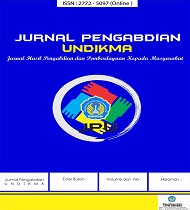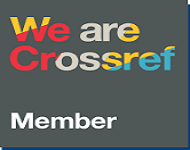The Unex Application as An English Interactive Learning Media : A Feasibility Study
DOI:
https://doi.org/10.33394/jk.v9i2.7794Keywords:
Interactive Learning Media, Unex Application, Understanding English, Feasibility.Abstract
This study aims to analyze the feasibility of Unex application as an interactive learning media in enhancing students' understanding of English texts. Unex stands for Understanding English Text application. The study used research and development (R&D) method with the ADDIE model. The subject of this research was eleventh-grade students at Health Vocational School of North Borneo that use android smartphones. The research instruments were questionnaires and validation sheets. The questionnaire was a media practicality questionnaire used to find out the practicality of the media used by teachers after a try-out of the Unex Application. Furthermore, Validation sheets were used to validate the Unex Application. The analysis technique used to explain the response is descriptive analysis, which involves calculating the total, average, percentage and then is adjusted and categorized into several categories. The result showed that the validation from media and material experts for the Unex application was 96% and 98.4%, and both were in very feasible categories. Also, the result from the media practicality was 92.8%. Therefore, the Unex application is well-developed as an English interactive learning media for students Health Vocational School of North Borneo. Moreover, the media and material in the Unex application were validated and declared with good scores and very feasible categories.
References
Adewoye, S. E., & Olaseni, A. O. (2022). A Systematic Review of Factors that Influences the Efficacy of Computer Based Learning. JETL (Journal of Education, Teaching and Learning), 7(2), 166-175.
Affandi, G. R., Amir, M. F., & Widyastuti, W. (2022). Teachers’ General Pedagogical Knowledge and self-efficacy On STEM Instructional Practices On Primary Teacher. JETL (Journal of Education, Teaching and Learning), 7(2), 176-183.
Afify, M. K. (2020). E-Learning Environments on Cognitive Load , Cognitive. Turkish Online Journal of Distance Education, 21(4), 68–89.
Ahmad, H. (2022). Effects of Interactive Media on Critical and Creative Thinking Mochamad. Jurnal Pendidikan Jasmani Dan Olahraga, 7(1), 104–109. https://scholar.archive.org/work/edskqbhzcrgb3ggjpvvtbmr2x4/access/wayback/https://ppjp.ulm.ac.id/journal/index.php/multilateralpjkr/article/download/10684/7997
Antara, I. G. W. S., & Dewantara, K. A. K. (2022). E-Scrapbook: The Needs of HOTS Oriented Digital Learning Media in Elementary Schools. Journal of Lesson and Learning Studies, 5(1), 71–76.
Arifin, Norain, S., & Ridwan. (n.d.). ESP COURSE DESIGN: The Need Analysis on English For Tourism Book for Travel Business Department of Eleventh Grade Students at SMKN 1 Tarakan. www.techniumscience.com
Asfihana, R. (2017). Teaching English For Specific Purposes (ESP) in EFL Context. LET Linguistics, Literature and English Teaching Journal 3, 24–33.
Azis, H. (2019). Validitas, Realibilitas, Praktikalitas, Dan Efektifitas bahan Ajar Cetak Meliputi Hand Out, Modul, Buku (Diktat, Buku Ajar, Buku Teks).
Bao, L., Xing, Z., Xia, X., & Lo, D. (2019). VT-Revolution: Interactive Programming Video Tutorial Authoring and Watching System. IEEE Transactions on Software Engineering, 45(8), 823–838. https://doi.org/10.1109/TSE.2018.2802916
Cladis, A. E. (2020). A shifting paradigm: An evaluation of the pervasive effects of digital technologies on language expression, creativity, critical thinking, political discourse, and interactive processes of human communications. E-Learning and Digital Media, 17(5), 341–364. https://doi.org/10.1177/2042753017752583
Diartono, D. A. (2008). Media Pembelajaran Desain Grafis Menggunakan Photoshop Berbasis Multimedia. Jurnal Teknologi Informasi Dinamik, 13(2), 155–167.
Dwitiyanti, N., Kumala, S. A., & Widiyatun, F. (2020). Using the ADDIE Model in the Development of Physics Unit Conversion Application Based on Android as Learning Media. Jurnal Ilmiah Pendidikan MIPA, 10(2), 125–132.
Jengathe, G., & V. Rojatkar, D. (2015). Use of Android in Education System. International Journal of Electrical and Electronics Research, 3(4), 133–137.
Kirkorian, H. L. (2018). When and How Do Interactive Digital Media Help Children Connect What They See On and Off the Screen? Child Development Perspectives, 12(3), 210–214. https://doi.org/10.1111/cdep.12290
Kissi, L., & Dreesmann, D. (2018). Plant visibility through mobile learning? Implementation and evaluation of an interactive Flower Hunt in a botanic garden. Journal of Biological Education, 52(4), 344–363. https://doi.org/10.1080/00219266.2017.1385506
Lee, W. W., & Owens, D. L. (2004). Multimedia-Based Instructional Design (R. Taff, Ed.; Second). Pfeiffer.
Oh, J., Bellur, S., & Sundar, S. S. (2018). Clicking, Assessing, Immersing, and Sharing: An Empirical Model of User Engagement with Interactive Media. Communication Research, 45(5), 737–763. https://doi.org/10.1177/0093650215600493
Pal, S., Pramanik, P. K. D., & Choudhury, P. (2019). A step towards smart learning: Designing an interactive video-based m-learning system for educational institutes. International Journal of Web-Based Learning and Teaching Technologies, 14(4), 26–48. https://doi.org/10.4018/IJWLTT.2019100102
Peebles, A., Bonus, J. A., & Mares, M. L. (2018). Questions + answers + agency: Interactive touchscreens and Children’s learning from a socio-emotional TV story. Computers in Human Behavior, 85, 339–348. https://doi.org/10.1016/j.chb.2018.03.039
Pelangi, G. (2020). Pemanfaatan Aplikasi Canva Sebagai Media Pembelajaran Bahasa Dan Sastra Indonesia Jenjang SMA/MA. Jurnal Sasindo Unpam, 8(2), 1–18. http://www.openjournal.unpam.ac.id/index.php/Sasindo/article/view/8354
Puspitarini, Y. D., & Hanif, M. (2019). Using Learning Media to Increase Learning Motivation in Elementary School. Anatolian Journal of Education, 4(2), 53–60. https://doi.org/10.29333/aje.2019.426a
Rachmadtullah, R., Zulela, M. S., & Sumantri, M. S. (2018). Development of computer-based interactive multimedia: Study on learning in elementary education. International Journal of Engineering and Technology(UAE), 7(4), 2035–2038. https://doi.org/10.14419/ijet.v7i4.16384
Rahim, F. R., Nabila, P., Sari, S. Y., & Suherman, D. S. (2022). Interactive Learning Media for Critical and Creative Thinking Skills Development. Pillar Of Physics Education, 15(4), 235–244.
Rohaeti, E. E., Bernard, M., & Primandhika, R. B. (2019). Developing interactive learning media for school level mathematics through open-ended approach aided by visual basic application for excel. Journal on Mathematics Education, 10(1), 59–68. https://doi.org/10.22342/jme.10.1.5391.59-68
Sanchez-Sepulveda, M. V., Fonseca, D., GarcÃa-Holgado, A., GarcÃa-Peñalvo, F. J., Franquesa, J., Redondo, E., & Moreira, F. (2020). Evaluation of an interactive educational system in urban knowledge acquisition and representation based on students’ profiles. Expert Systems, 37(5), 1–17. https://doi.org/10.1111/exsy.12570
Skulmowski, A., & Rey, G. D. (2020). Subjective cognitive load surveys lead to divergent results for interactive learning media. Human Behavior and Emerging Technologies, 2(2), 149–157. https://doi.org/10.1002/hbe2.184
Snyder, L. S., Lin, Y. S., Karimzadeh, M., Goldwasser, D., & Ebert, D. S. (2020). Interactive Learning for Identifying Relevant Tweets to Support Real-time Situational Awareness. IEEE Transactions on Visualization and Computer Graphics, 26(1), 558–568. https://doi.org/10.1109/TVCG.2019.2934614
Sokol, K., & Flach, P. (2020). One Explanation Does Not Fit All: The Promise of Interactive Explanations for Machine Learning Transparency. KI - Kunstliche Intelligenz, 34(2), 235–250. https://doi.org/10.1007/s13218-020-00637-y
Sugihartini, N., & Yudiana, K. (2018). Addie Sebagai Model Pengembangan Media Instruksional Edukatif (Mie) Mata Kuliah Kurikulum Dan Pengajaran. Jurnal Pendidikan Teknologi Dan Kejuruan, 15(2), 277–286. https://doi.org/10.23887/jptk-undiksha.v15i2.14892
Sugiyono. (2013). Metode Penelitian Kuantitatif, Kualitatif dan R&D.
Sukmawati, E., Fitriadi, H., Pradana, Y., Dumiyati, Arifin, Saleh, S., Trustisari, H., Wijayanto, P. A., Khasanah, & Rinaldi, P. A. (n.d.). DIGITALISASI SEBAGAI PENGEMBANGAN MODEL PEMBELAJARAN Penerbit Cendikia Mulia Mandiri.
Suparman, I. W., Eliyanti, M., & Hermawati, E. (2020). Pengaruh Penyajian Materi Dalam Bentuk Media Komik Terhadap Minat Baca Dan Hasil Belajar. Pedagogi: Jurnal Penelitian Pendidikan, 7(1), 57–64. https://doi.org/10.25134/pedagogi.v7i1.2860
Syawaludin, A., Gunarhadi, & Rintayati, P. (2019). Development of augmented reality-based interactive multimedia to improve critical thinking skills in science learning. International Journal of Instruction, 12(4), 331–344. https://doi.org/10.29333/iji.2019.12421a
Thomä, J., & Zimmermann, V. (2020). Interactive learning — The key to innovation in non-R&D-intensive SMEs? A cluster analysis approach. Journal of Small Business Management, 58(4), 747–776. https://doi.org/10.1080/00472778.2019.1671702
Vega, N. de, & Arifin, A. (2022, March 30). Teachers’ Experiences of Implementing D-Learning. https://doi.org/10.4108/eai.27-11-2021.2315536
Wahid, R. N., & Cerya, E. (2022). Development of Android-Based Interactive Media Learning Economics Capital Market Materials. Economic Education Analysis Journal, 11(1), 50–64. https://doi.org/10.15294/eeaj.v11i1.53713
Downloads
Published
How to Cite
Issue
Section
Citation Check
License
License and Publishing Agreement
In submitting the manuscript to the journal, the authors certify that:
- They are authorized by their co-authors to enter into these arrangements.
- The work described has not been formally published before, except in the form of an abstract or as part of a published lecture, review, thesis, or overlay journal.
- That it is not under consideration for publication elsewhere,
- That its publication has been approved by all the author(s) and by the responsible authorities tacitly or explicitly of the institutes where the work has been carried out.
- They secure the right to reproduce any material that has already been published or copyrighted elsewhere.
- They agree to the following license and publishing agreement.
Copyright
Authors who publish with JK agree to the following terms:
- Authors retain copyright and grant the journal right of first publication with the work simultaneously licensed under a Creative Commons Attribution License (CC BY-SA 4.0) that allows others to share the work with an acknowledgment of the work's authorship and initial publication in this journal.
- Authors are able to enter into separate, additional contractual arrangements for the non-exclusive distribution of the journal's published version of the work (e.g., post it to an institutional repository or publish it in a book), with an acknowledgment of its initial publication in this journal.
- Authors are permitted and encouraged to post their work online (e.g., in institutional repositories or on their website) prior to and during the submission process, as it can lead to productive exchanges, as well as earlier and greater citation of published work.
Licensing for Data Publication
-
Open Data Commons Attribution License, http://www.opendatacommons.org/licenses/by/1.0/ (default)

This work is licensed under a Creative Commons Attribution-ShareAlike 4.0 International License.







